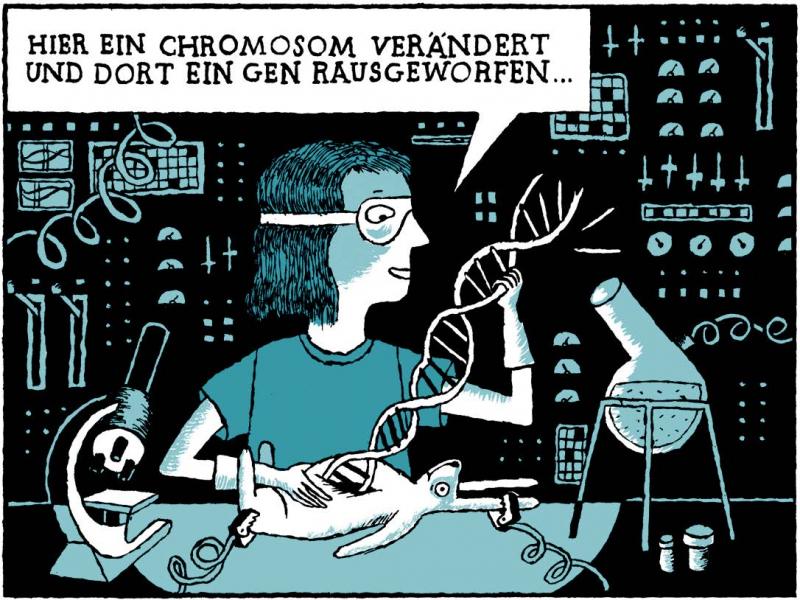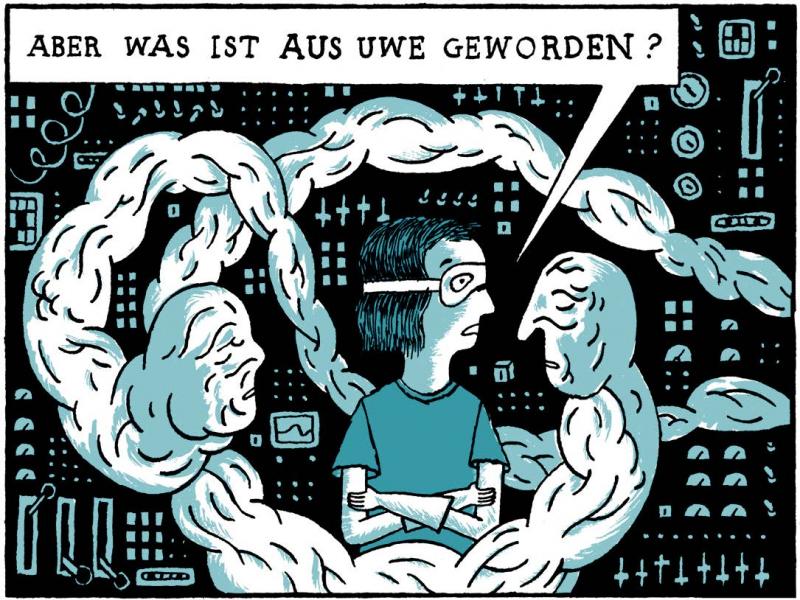Humankind’s influence is no longer limited to the geological surface of the Earth; it now also significantly impacts genetic landscapes. A few decades ago, breeding efforts were limited to combining the genetic materials of existing agricultural plants and farm animals. Today, biotechnicians are creating new types of plants and animal species in their labs: from genetically altered plants to bacteria with synthetically created DNA. “Traditional” biotechnology starts with the established genome of an existing organism and changes it, while “synthetic” biology aims to circumvent evolution completely and create life using so-called “Bio Bricks.” If we can create life in a laboratory, thereby turning it into a consumable to be patented and traded, are we running the risk of losing our respect for life?

Biotechnology: Goats and Tissue Culture
Till Lukat
Biotechnology: Goats and Tissue Culture
Till Lukat
Drawn by Till Lukat , 2014.  This work is licensed under a Creative Commons Attribution-NonCommercial-NoDerivatives 4.0 International License.
This work is licensed under a Creative Commons Attribution-NonCommercial-NoDerivatives 4.0 International License.
Goats and Tissue Culture: Biotechnology
Text and images by Till Lukat
University of the Arts (UdK), Berlin

The Model Gene Kit
Father - “Well, the time has come. Your mother and I think that you have finally reached the right age for this.”
Daughter - “My own biology lab!”
The Model Gene Kit
Father - “Well, the time has come. Your mother and I think that you have finally reached the right age for this.”
Daughter - “My own biology lab!”
Drawn by Till Lukat , 2014.  This work is licensed under a Creative Commons Attribution-NonCommercial-NoDerivatives 4.0 International License.
This work is licensed under a Creative Commons Attribution-NonCommercial-NoDerivatives 4.0 International License.

“Don’t worry, Uwe. You’re just my guinea pig.”
“Don’t worry, Uwe. You’re just my guinea pig.”
Drawn by Till Lukat , 2014.  This work is licensed under a Creative Commons Attribution-NonCommercial-NoDerivatives 4.0 International License.
This work is licensed under a Creative Commons Attribution-NonCommercial-NoDerivatives 4.0 International License.

“Change a chromosome here, take out a gene there…”
“Change a chromosome here, take out a gene there…”
Drawn by Till Lukat , 2014.  This work is licensed under a Creative Commons Attribution-NonCommercial-NoDerivatives 4.0 International License.
This work is licensed under a Creative Commons Attribution-NonCommercial-NoDerivatives 4.0 International License.

“…maybe I should have analyzed the DNA first.”
“…maybe I should have analyzed the DNA first.”
Drawn by Till Lukat , 2014.  This work is licensed under a Creative Commons Attribution-NonCommercial-NoDerivatives 4.0 International License.
This work is licensed under a Creative Commons Attribution-NonCommercial-NoDerivatives 4.0 International License.

“Hello, little girl. I’m Flora, green biotechnology. I mess with plants.”
“Hello, little girl. I’m Flora, green biotechnology. I mess with plants.”
Drawn by Till Lukat , 2014.  This work is licensed under a Creative Commons Attribution-NonCommercial-NoDerivatives 4.0 International License.
This work is licensed under a Creative Commons Attribution-NonCommercial-NoDerivatives 4.0 International License.

“And I’m Fauna, red biotechnology. I enhance animals, and in doing so, I help humans.”
“And I’m Fauna, red biotechnology. I enhance animals, and in doing so, I help humans.”
Drawn by Till Lukat , 2014.  This work is licensed under a Creative Commons Attribution-NonCommercial-NoDerivatives 4.0 International License.
This work is licensed under a Creative Commons Attribution-NonCommercial-NoDerivatives 4.0 International License.

“But what happend to Uwe?”
“But what happend to Uwe?”
Drawn by Till Lukat , 2014.  This work is licensed under a Creative Commons Attribution-NonCommercial-NoDerivatives 4.0 International License.
This work is licensed under a Creative Commons Attribution-NonCommercial-NoDerivatives 4.0 International License.

“We’ll cure you of disease, we’ll feed you. You don’t need Uwe anymore. You have us.”
“We’ll cure you of disease, we’ll feed you. You don’t need Uwe anymore. You have us.”
Drawn by Till Lukat , 2014.  This work is licensed under a Creative Commons Attribution-NonCommercial-NoDerivatives 4.0 International License.
This work is licensed under a Creative Commons Attribution-NonCommercial-NoDerivatives 4.0 International License.
Artist’s comment:
Biotechnology is omnipresent in all areas from medicine to agriculture. It would not be possible to produce certain medicines or vaccines without it. Genetic engineering also plays a major albeit controversial role in biotechnology. Does biotechnology cross ethical borders or is it okay to manipulate DNA if it could help make sick people well again?
How to cite
Lukat, Till. “Biotechnology.” Environment & Society Portal, Multimedia Library, 2014. http://www.environmentandsociety.org/node/6628/.
The comic also appears in Alexandra Hamann, Reinhold Leinfelder, Helmuth Trischler, and Henning Wagenbreth, eds., Anthropozän – 30 Meilensteine auf dem Weg in ein neues Erdzeitalter. Eine Comic-Anthologie (Munich: Deutsches Museum, 2014).
This work is licensed under a Creative Commons Attribution-NonCommercial-NoDerivatives 4.0 International License.

